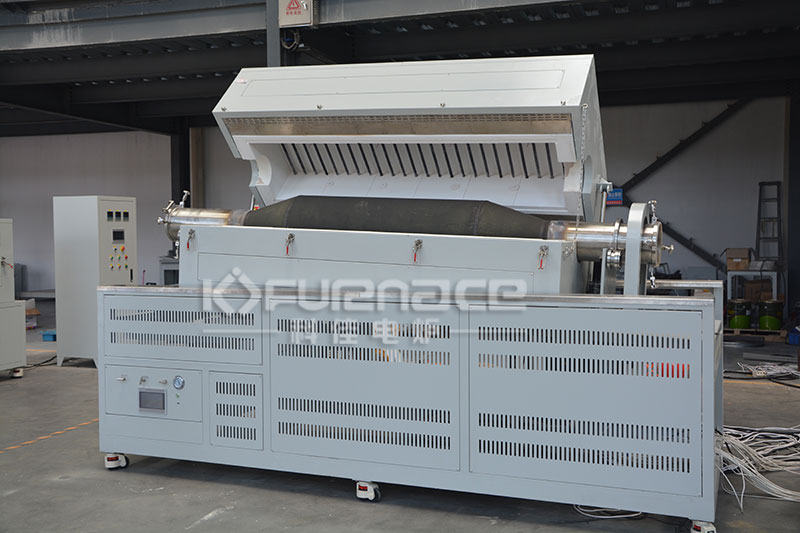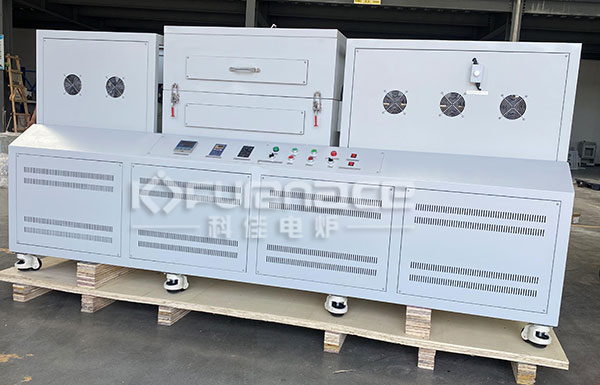Industrial multi temperature zone rotary furnace is an efficient industrial equipment that combines rotating cylinder with independent temperature control technology in multiple temperature zones to achieve dynamic heat treatment of materials. It is widely used in lithium battery materials, metallurgy, chemical industry, environmental protection and other fields, with advantages such as precise temperature control, uniform heating of materials, and strong adaptability. Let’s take a detailed look at the industrial multi temperature zone rotary furnace below!

Rotating tube furnace commonly used for powder sintering (click on the image to view product details)
1. Core working principle
Dynamic heating mechanism
The furnace body is a long cylindrical structure lined with refractory materials, and is slowly rotated by an electric motor through gears (with adjustable speed). The material is added from the high end and gradually moves towards the low end as the furnace rotates and tilts (with adjustable inclination angle), achieving axial movement under the action of gravity. During this process, the material receives radiation, convection, and conduction heating from an external heat source, completing processes such as calcination, roasting, or drying.
Independent temperature control in multiple temperature zones
The furnace body is divided into multiple independent temperature zones along the axial direction (such as preheating zone, firing zone, cooling zone), each of which is equipped with an independent heating system and temperature sensor. The PID intelligent algorithm is used to achieve precise temperature control (accuracy ± 1 ℃). For example, the sintering of ternary precursors for lithium battery materials requires the completion of crystal transformation in a specific temperature range, and the accuracy of temperature control directly affects the material properties.
2. Technical advantages
temperature uniformity
Dynamic rotation causes the material to continuously roll, eliminating local overheating or underheating phenomena. Combined with multi temperature zone temperature control, it ensures that the material is uniformly heated at each stage. For example, in the production of alumina, aluminum hydroxide is calcined at 1200 ℃ to form α – Al ₂ O3, and temperature uniformity ensures product conversion rate.
Process adaptability
By adjusting the number of temperature zones, temperature curve, furnace rotation speed, and inclination angle, it is possible to adapt to the heat treatment needs of different materials. For example:
Lithium battery materials: sintering of lithium iron phosphate requires control of tap density, and preparation of silicon carbon negative electrode requires ultra-high temperature treatment;
Metallurgical industry: Direct reduction of iron ore (DRI process) requires a CO/H ₂ reduction atmosphere, resulting in a higher metallization rate;
Environmental protection field: Medical waste treatment requires high temperature decomposition at 1100 ℃, resulting in lower dioxin emissions.
Continuous homework ability
Materials are continuously added from one end and discharged from the other end, achieving 24-hour uninterrupted production and significantly increasing production capacity.
3. Typical application scenarios
Production of lithium battery materials
Positive electrode material: The ternary precursor undergoes crystal transformation in a rotary furnace, with a temperature control accuracy of ± 1 ℃;
Negative electrode material: Graphite negative electrode needs to be sintered at 1000-1200 ℃ to improve compaction density and conductivity.
metallurgical industry
Iron ore reduction: In the DRI process, the rotary furnace provides a CO/H ₂ reduction atmosphere, resulting in a higher metallization rate;
Zinc leaching residue treatment: Recovering valuable metals such as zinc and lead with better recovery rates.
chemical engineering field
Titanium dioxide production: The conversion rate of rutile type is high, and the particle size D50 can be controlled at the standard value;
Catalyst preparation: Porous support has a higher specific surface area.
Environmental Protection Treatment
Hazardous waste incineration: The thermal reduction rate is smaller, meeting the standards;
Fly ash melting: The solidification rate of heavy metals is higher.

Commonly used vacuum powder rotary tube furnace (click on the picture to view product details)
4. Summary
Industrial multi temperature zone rotary furnaces are commonly used in processes such as battery positive and negative electrode material sintering, powder annealing sintering, sea mud drying, and ceramic powder sintering due to their wide application scenarios. They have the characteristics of uniform temperature field and large processing capacity. Before customization, you can communicate with relevant technical personnel about the parameters you want, so as to customize industrial multi temperature zone rotary furnaces that are more suitable for your own production!Click to learn more tube furnaces! Or click on online customer service to learn more about product information!